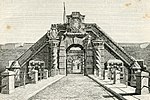Ciane
Drainage basins of the Ionian SeaRivers of ItalyRivers of SicilyRivers of the Province of Syracuse

The Ciane (Sicilian: Ciani) is a short river in southern Sicily, Italy. It flows into the Ionian Sea near Syracuse, after a run of 8 kilometres (5 mi), at a common mouth with the Anapo. The name, deriving from the Greek cyanos ("azure"), is connected to the myth of Anapos and the nymph Cyane. On its banks are present spontaneous grows of papyrus (Cyperus papyrus), probably sent to Hiero II of Syracuse by the Egyptian ruler Ptolemy II Philadelphus. The area is now protected as part of the Natural Preserve of Fiume Ciane and Saline di Siracusa, created in 1984.
Excerpt from the Wikipedia article Ciane (License: CC BY-SA 3.0, Authors, Images).Ciane
Via Elorina, Syracuse
Geographical coordinates (GPS) Address Nearby Places Show on map
Geographical coordinates (GPS)
| Latitude | Longitude |
|---|---|
| N 37.0549 ° | E 15.2701 ° |
Address
Circolo nautico Ciane
Via Elorina
96100 Syracuse
Sicily, Italy
Open on Google Maps











